| |
|
Harvestmen, Daddy-long-legs
Harvestman, order Opiliones
|
Harvestmen, order Opiliones, are very common in most parts of the United States. They're popularly known as “daddy-long-legs" or "grand-daddy-long-legs". Although harvestmen are somewhat spider-like in appearance, they aren't true spiders. They don't possess silk glands, produce no webs, are non-venomous, and are more closely related to mites.
Late summer and fall is when harvestmen are most commonly seen, which is most likely how their name was derived. The French names for this arthropod are similar in meaning; faucheux, faucheurs, meaning haymaker or reaper. Afterspinnen (pseudo-spiders) and zimmermaenner (carpenters) are their German names. Other English names are harvest-spiders, shepherd-spiders and grandfather-graybeards. The common name daddy-long-legs is also used in conjunction with crane flies and cellar spiders in the family Pholcidae. |
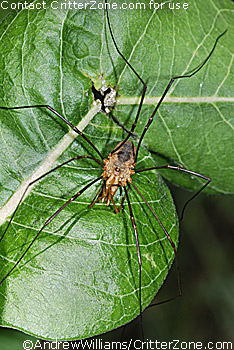 Harvestman, daddy-long-legs, Opiliones
Harvestman, daddy-long-legs, Opiliones
|
| Most harvestmen can be recognized by their very long and slender legs, but some species have relatively short legs. Their carapace (upper body shield) is segmented indistinctly, if at all. The abdomen and cephalothorax are virtually fused and oval in shape, which visually distinguishes them from spiders. |
| It's not easy to determine the gender of harvestmen. With some harvestmen there are no obvious secondary sexual characteristics, but with most of them there are differences in size, color and proportions of the appendages. Usually the male's body is smaller, shorter and more brilliantly colored than that of the female; however, the female's markings tend to be more distinct. Males tend to have longer legs, as well as more distinct granulations and spines. The chelicerae (front mouth parts) and pedipalps (sensory appendages near the mouth) also tend to differ between male and female daddy-long-legs. |
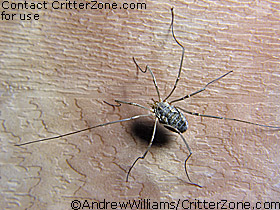 Harvestman, daddy-long-legs, Opiliones
Harvestman, daddy-long-legs, Opiliones
|
| Harvestmen front mouth organs are three-jointed and chelate (claw-like), with the third joint forming the finger of a claw. They're relatively long, and, in some forms, quite sturdy. They usually have an ankle claw, and their pedipalps look like legs but are much shorter. Like humans, harvestmen have only one pair of eyes. Theirs are located on top of a bump near the middle of the cephalothorax, and each eye aims somewhat outward, facing each respective side. |
| Harvestmen legs are very long and slender, except for the segments nearest the body, which are relatively sturdy and appear to be fused with the body. These leg portions are called coxae. Although harvestmen have stilt-like legs, they don't raise their bodies much above the ground when walking. They carry it down low with the middle part of their legs high in the air. When disturbed, they stand on six legs and wave the second pair in the air, sensing their surroundings. |
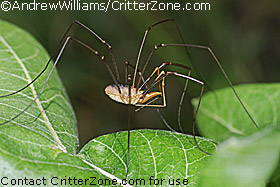 Harvestman, daddy-long-legs, Opiliones
Harvestman, daddy-long-legs, Opiliones
|
In the northern part of the United States, most harvestmen die in the fall after eggs are laid, but, in southern states, they hide under organic matter through the winter. Using an ovipositor that can be extended to a great length, their eggs are laid in the ground, under stones, or in crevices of wood. Harvestmen eggs don't hatch until spring.
As for their eating habits, adults usually hide during the day and begin foraging at twilight. They're generally carnivorous, feeding on live invertebrate prey. Some species prefer to dine on dead animals or juices from plants, fruits and veggies. |
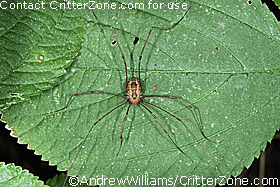 Harvestman, daddy-long-legs, Opiliones
Harvestman, daddy-long-legs, Opiliones
|
It's generally thought that the length of harvestmen legs, combined with the fact that they easily detach from the body, serves as a means of protection from predators. In attempting to capture the harvestmen, an enemy is almost sure to seize a leg instead of the juicy middle. If a leg becomes detached, it may continue to twitch independently as if alive, further confusing a predator. Harvestmen have one other defensive strategy, the art of stench. When disturbed, they emit a foul odor from their scent glands. To would be predators, this is a clear warning that harvestmen taste terrible.
Andy Williams / CritterZone.com |
The harvestmen, daddy-long-legs, Opiliones pictures on this page are available for commercial stock photography license. All text and photos that appear on this webpage are copyrighted and may not be copied or used in any way without permission from CritterZone.
CritterZone does not specifically endorse our advertisers, or their methods. We cannot control the ads that run on our articles. CritterZone advocates humane and respectful treatment of all creatures.
Save this page:

|
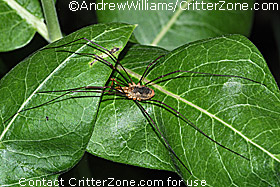 Harvestmen, daddy-long-legs, Opiliones
Harvestmen, daddy-long-legs, Opiliones
|
|
|
|